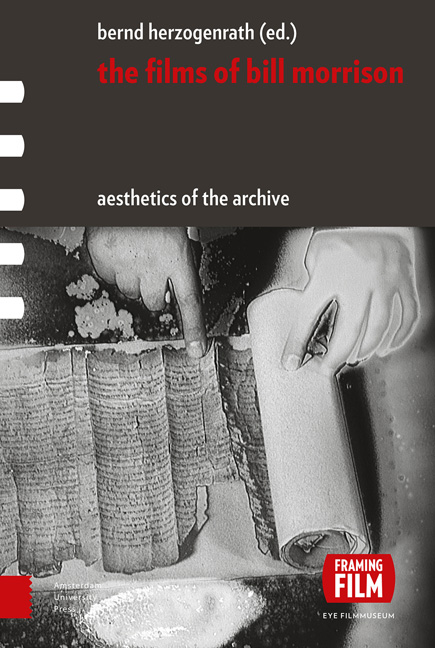Book contents
- Frontmatter
- Contents
- Acknowledgments
- Aesthetics of the Archive: An Introduction
- Chapter 1 Drafts and Fragments: Reflections around Bill Morrison and the Paper Print Collection
- Chapter 2 The Film of Her: The Cine-Poet Laureate of Orphan Films
- Chapter 3 Ghost Trip: Searching for Potential Myths
- Chapter 4 Decasia: The Matter | Image: Film is also a Thing
- Chapter 5 The Mesmerist: Illustrating the Return of the Repressed
- Chapter 6 Light is Calling: Celluloid Dreams
- Chapter 7 Gotham: Zoetrope: Block by Block
- Chapter 8 Outerborough: Early Cinema Revisited
- Chapter 9 The Highwater Trilogy: Thinking the Liquid – On the Ethics of Water and the Material Ecologies of Disaster and Ruination
- Chapter 10 Porch: Archives, Collective Memory, and the Poetics of Home Movies
- Chapter 11 The Future Lasts Long: The Romanov Lost Family Archives
- Chapter 12 Who by Water: Variations on Matter, Figures, Memory, and Mythology
- Chapter 13 Every Stop on the F-Train: Beyond and within the Restless Netherworld of (Manhattan’s) Mind
- Chapter 14 Spark of Being: Bachelor Machine
- Chapter 15 The Miners’ Hymns: Acts of Resurrection
- Chapter 16 Tributes – Pulse: A Requiem for the 20th Century: Death | Drive | Image
- Chapter 17 Just Ancient Loops: The Loops of Life in Intonation
- Chapter 18 The Great Flood: Water is Transparence Derived from the Presence of Everything
- Chapter 19 Re-Awakenings: Bill Morrison in Conversation
- Index of Film Titles
- Index of Names
- Index of Subjects
- Already Published
Chapter 17 - Just Ancient Loops: The Loops of Life in Intonation
Published online by Cambridge University Press: 12 December 2020
- Frontmatter
- Contents
- Acknowledgments
- Aesthetics of the Archive: An Introduction
- Chapter 1 Drafts and Fragments: Reflections around Bill Morrison and the Paper Print Collection
- Chapter 2 The Film of Her: The Cine-Poet Laureate of Orphan Films
- Chapter 3 Ghost Trip: Searching for Potential Myths
- Chapter 4 Decasia: The Matter | Image: Film is also a Thing
- Chapter 5 The Mesmerist: Illustrating the Return of the Repressed
- Chapter 6 Light is Calling: Celluloid Dreams
- Chapter 7 Gotham: Zoetrope: Block by Block
- Chapter 8 Outerborough: Early Cinema Revisited
- Chapter 9 The Highwater Trilogy: Thinking the Liquid – On the Ethics of Water and the Material Ecologies of Disaster and Ruination
- Chapter 10 Porch: Archives, Collective Memory, and the Poetics of Home Movies
- Chapter 11 The Future Lasts Long: The Romanov Lost Family Archives
- Chapter 12 Who by Water: Variations on Matter, Figures, Memory, and Mythology
- Chapter 13 Every Stop on the F-Train: Beyond and within the Restless Netherworld of (Manhattan’s) Mind
- Chapter 14 Spark of Being: Bachelor Machine
- Chapter 15 The Miners’ Hymns: Acts of Resurrection
- Chapter 16 Tributes – Pulse: A Requiem for the 20th Century: Death | Drive | Image
- Chapter 17 Just Ancient Loops: The Loops of Life in Intonation
- Chapter 18 The Great Flood: Water is Transparence Derived from the Presence of Everything
- Chapter 19 Re-Awakenings: Bill Morrison in Conversation
- Index of Film Titles
- Index of Names
- Index of Subjects
- Already Published
Summary
ABSTRACT
Just Ancient Loops is a ternary audiovisual symphony with great emphasis on the interplay between the music and the visuals. Together, the three parts – a largo Genesis, an allegro Chorale, and the largo final Ascension – present different views on heaven.
Music is neither only accompanying the images, like a soundtrack in a film, nor are the images just expressions of the music, as is commonly the case in music videos. Morrison's imagery and Harrison's composition create, through multifold bilateral reference, a phenomenon one might call übersynchresis, a term elaborated on grounds of the acronym synchresis by film theorist Michel Chion in order to describe a permanent correlation between music and image.
KEYWORDS
symphony, synchresis, über-synchresis, audiovisual correlation
Bill Morrison's audiovisual film Just Ancient Loops consists of three parts that are typical for a symphony: a largo Genesis, an allegro Chorale, and the largo final Ascension. The imagery, mainly decaying pre-1950s nitrate celluloid film footage, is supplemented with high-definition CGI animation based on NASA data. The found-footage material was sourced from two archives: the Moving Image Research Collections at the University of South Carolina and the Audiovisual Preservation at the Library of Congress. The images are taken from feature films, documentaries, and ephemeral films – advertisements as well as industrial, educational, and amateur films – and are all in various states of decay, as shown by their blisters and scratches.
Michael Harrison, one of the most innovative composers in recent years, created the music that accompanies the visuals. In the piece, entitled Time Loops, he refined ancient tuning systems to develop Just Intonation, a tuning system wherein the distances between notes are based upon whole number ratios. Morrison reflects on Harrison's musical creation through the CGI animation. These animations are based on the research of Walter Murch, who found a connection between the overtone formula and the orbits of the planets. This interplay constitutes the quintessential musical and visual correlation of the film.
The multilayered cello composition was played by the exceptionally gifted cellist Maya Beiser. Beiser performed the piece live at the premiere at Bang On A Can Festival 2012 and hence turned the screening into a performance. The fact that the music was played live during the screening clearly emphasizes the music and hence influences the audiovisual reception.
- Type
- Chapter
- Information
- The Films of Bill MorrisonAesthetics of the Archive, pp. 253 - 264Publisher: Amsterdam University PressPrint publication year: 2017



